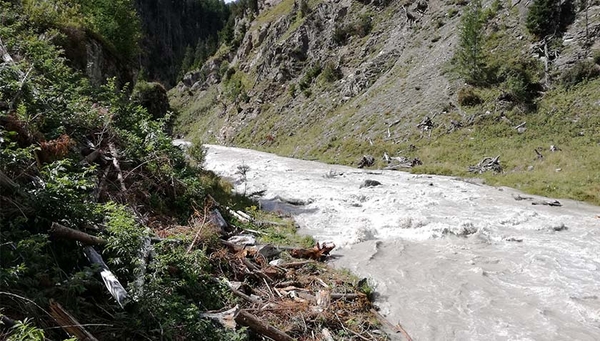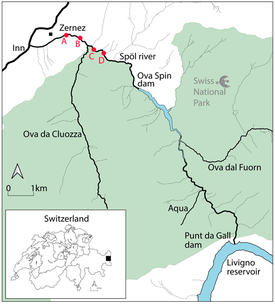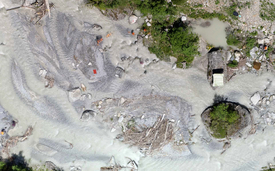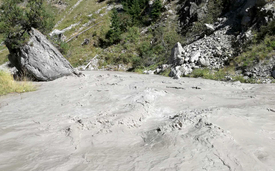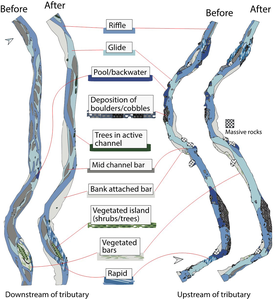News Detail
Restoring dammed rivers using artificial floods
March 29, 2022 |
Naturally, water levels of rivers and streams are variable and fluctuate between drier and wetter periods. Spring snowmelt and the timing and location of rainfall events often drive these fluctuations, especially in alpine areas. Sediment and adsorbed nutrients are mobilised by flowing water and transported through river valleys. This, in turn, helps shape the river, its pools and riffles, and connection with the floodplain. Natural stream systems have healthy riverside vegetation and sources of organic matter that form part of the food web (Robinson, C.T. et al., Freshwater biology, 2002), sustaining aquatic insects, fish and other organisms. The hydrology, geomorphology and ecology of natural rivers are in harmony. Dams change all of this.
Dams can change a river’s natural flow
Worldwide, there are more than 55,000 large dams used for the benefit of societies, be it for drinking water supply, irrigation, flood mitigation, or hydro-electric power generation. On the downside, dams can drastically change a river’s natural flow, particularly its variability and the size and timing of floods. This is called ‘river regulation’. The reservoirs formed behind dams trap most of the incoming sediment, starving the river and its ecosystems downstream. River channels can narrow or cut deeper. These changes affect riparian vegetation, degrade aquatic habitat and can lead to the collapse of entire food webs or even ecosystems. Adaptive dam management nowadays can use artificial floods (Robinson, C.T et al. Freshwater Science, 2018) to reintroduce some of the elements of natural flow variability into these degraded catchments.
Spöl river catchment as a case study
Little is known about the ecological benefits of these floods as they are not used regularly in many locations. In a recent study, published in Journal of Environmental Management (Consoli, G. et al., 2022), we used the Spöl river catchment as a case study to compare responses to artificial floods upstream and downstream of a free flowing tributary. Results are intended to be translated and applied to restoring other managed rivers, including the role of natural tributaries.
The Spöl catchment arises in the Central Alps and forms part of the Danube basin (Figure 1). Two large dams (Punt da Gall and Ova Spin) were built between 1960 and 1970 for electricity production, regulating the flow of the Spöl. The freely flowing Ova da Cluozza joins the Spöl mid-way between the Ova Spin dam and the river’s junction with the Inn River near Zernez. The Ova da Cluozza’s water levels vary substantially by season, including low winter flows and periodic rainfall or snowmelt-generated floods, reminiscent of the Spöl prior to dam construction.
Figure 1. Location of the study area, Punt da Gall and Ova Spin dams. A-D indicate the location of sampling sites for before/after and during each flood. A, B are located below the junction with the tributary (Ova da Cluozza); C, D are located above. Site D and site A mark the boundaries of the drone flights.
(Figure: Elsevier /
doi.org/10.1016/j.jenvman.2021.114122)
Artificial floods, controlled releases of water from the two dams, were introduced in 2000 and occur one or two times per year. We studied the response of the Spöl, upstream and downstream of the Ova da Cluozza junction, to artificial floods on 4 September 2018 and 19 July 2019. The idea was to compare responses between a river reach characterised by stable conditions (above tributary) and one, more dynamic, disturbed by periodic natural floods (below tributary). Each flood lasted eight hours, with a peak flow of 25 cubic metres per second for around two hours. We sampled various aspects of water quality, riverbed sediments, organic matter and aquatic insects (macroinvertebrates) before, during and after the floods. We also carried out drone surveys of the river, taking high resolution images that we used to assess any changes in the river’s morphology (Figure 2).
Figure 2. Aerial image of the Spöl River at its confluence with the Ova da Cluozza, 19 July 2019. Geomorphologists can be seen in orange jackets carrying out a sediment transport study.
(Photo: Swiss National Park)
Artificial floods have caused disturbance to the system
We saw an immediate increase in river turbidity as the flow levels rose. The water was so turbid that it exceeded the detection limits of our field instruments (Figure 3). This was because the artificial floods mobilised sediment in the reservoir as well as on the riverbed. Total phosphorus and total nitrogen levels associated with the sediments were also elevated. At the same time, our sampling showed that the amount of transported organic matter and the number of insects and other macroinvertebrates entrained in the flow was markedly elevated.
Figure 3. Highly turbid water during the artificial flood at site D, 4 September 2018.
(Photo: Gabriele Consoli)
After the flood, no significant changes in the number (density) and diversity (taxa richness) of macroinvertebrates were recorded downstream of the tributary (sites A & B). However, upstream of the junction (sites C & D), we recorded a significant drop in density and taxa richness – which then recovered after about four weeks. This result confirmed our expectation that above the tributary the floods would have caused greater disturbance to the system. Both floods flushed the river of algae and organic matter on the riverbed, reducing levels at upstream and downstream sites.
Our drone surveys showed that the river’s morphology mostly changed downstream of the tributary after the artificial floods (Figure 4). The channel upstream of the tributary is narrow and shows signs of sediment depletion with vegetated sediment deposits (bars) detached from the stream, as is typical of a regulated river. The downstream section benefits from the free-flowing Ova da Cluozza carrying sediment and debris, which allow for much more dynamic changes in river morphology in response to artificial floods.
Figure 4. Predominant eco-morphological features before and after the artificial floods.
(Figure: Elsevier /
doi.org/10.1016/j.jenvman.2021.114122)
Sediments were redistributed and bars in the channel grew larger after the floods. The floods promoted lateral movement of the river and the enhancement of river morphology. The involvement of riparian vegetation resulted in the formation of valuable habitats within the floodplain, as normally seen in rivers unaffected by dams.
Artificial floods are essential to improve dammed rivers
The key takeaway message from our research is that artificial floods are essential to improve dammed rivers by restoring flow variability and physical disturbance. Unregulated tributaries help reduce the impacts of river regulation and enhance the benefits of artificial floods. In such a context, artificial floods are important in mobilising sediment provided by the tributary, which otherwise would accumulate at the confluence. In our future research, we aim to identify the ideal timing, magnitude and frequency of these floods to deliver the best outcomes for stream morphology and ecology, maintaining the societal benefits of dams while minimising impacts on the environment.
Cover Picture: An artificial flood on the Spöl River. (Photo: Gabriele Consoli, Eawag)
Original publication
Funding
This work was supported by the European Union's Horizon 2020 - Research and Innovation Framework Programme under the Marie Skłodowska-Curie grant agreement (MSCA) No. 765553.
Cooperations
- ETH Zurich
- Swiss National Park
- Zurich University of Applied Sciences (ZHAW)
- eQcharta GmbH
- University of Leeds, UK

